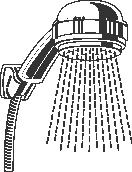|
Vol. 7, No. 2 Spring 1999 |
Subscribe to AT Messenger Download PDF Viewer |
Assistive Technology for Alzheimer's Disease
by Ed Salisbury, Kent County ATRC
As the population ages, the number of people with Alzheimer's Disease continues to grow. According to the Alzheimer's Association, Alzheimer's Disease affects one out of ten people over the age of 65. Those over the age of 85 have almost a 50% chance of getting the disease. Many times Medicare and private insurance companies do not provide adequate long-term coverage; therefore, 70% of those who have this progressive, degenerative disease of the brain are cared for at home by a family member.
Although there is currently no cure for Alzheimer's, products are available to help make life easier for people with this disease and to assist those who contribute to their care. Products designed to help with tasks such as bathing, mobility, and monitoring can be purchased from a variety of mail order catalogs as well as from local home health suppliers and even retail stores.
 Many people in later stages of
Alzheimer's disease find bathing and toileting difficult. The installation
of grab bars in the bathtub/shower as well as the addition of non-slip matting
can reduce the risk of injury due to falling. If the person is unable to
bathe independently, bath benches and removable showerheads make bathing
much easier for the caregiver or family member. If the person with Alzheimer's
is unable to enter the tub or shower area, a shampoo tray can be used by
the caregiver almost anywhere to wash his or her hair. When bathroom safety
is an issue, the EZ-Bathe allows complete bathing of the individual
without ever leaving the bed. He or she needs only roll into the vinyl tub
which is then inflated using a vacuum cleaner. The fill hose is then attached
to a faucet up to 25 feet away. Another hose is used to drain the tub into
the bathtub or sink.
Many people in later stages of
Alzheimer's disease find bathing and toileting difficult. The installation
of grab bars in the bathtub/shower as well as the addition of non-slip matting
can reduce the risk of injury due to falling. If the person is unable to
bathe independently, bath benches and removable showerheads make bathing
much easier for the caregiver or family member. If the person with Alzheimer's
is unable to enter the tub or shower area, a shampoo tray can be used by
the caregiver almost anywhere to wash his or her hair. When bathroom safety
is an issue, the EZ-Bathe allows complete bathing of the individual
without ever leaving the bed. He or she needs only roll into the vinyl tub
which is then inflated using a vacuum cleaner. The fill hose is then attached
to a faucet up to 25 feet away. Another hose is used to drain the tub into
the bathtub or sink.
Another problem facing many people with Alzheimer's is reduced mobility. For those who are able to walk but have problems with steps, the CairStair system reduces the height each leg must be lifted on standard size steps. Many people, especially in the latter stages of Alzheimer's, must use a wheelchair for mobility. This makes transfers from the chair to a bed or couch very difficult, especially if the individual is being assisted by an elderly spouse or family member. The BeasyTrans is a portable transfer aid providing friction-free, no-lift transfers.
 A common fear of most family members and caregivers
is that the person with Alzheimer's will wander from the house or long-term
care facility and become lost or injured. Products are available not only
to alert others in the house or facility to individuals wandering, but also
to prevent wanderers from gaining access to the outside. The BedTender
and ChairTender systems sound an alarm whenever the person leaves
the chair or bed. In a facility setting, the Resident I.D. monitors
each patient's location in the facility and alerts staff to attempted exits.
The system can also be set up to lock doors when a wandering patient approaches.
The WanderCare system acts as both a monitoring and tracking system.
Family or staff is alerted when the individual wanders from a designated
area. The WanderCare then acts as a tracking system allowing family
or staff to quickly locate the person before an accident occurs.
A common fear of most family members and caregivers
is that the person with Alzheimer's will wander from the house or long-term
care facility and become lost or injured. Products are available not only
to alert others in the house or facility to individuals wandering, but also
to prevent wanderers from gaining access to the outside. The BedTender
and ChairTender systems sound an alarm whenever the person leaves
the chair or bed. In a facility setting, the Resident I.D. monitors
each patient's location in the facility and alerts staff to attempted exits.
The system can also be set up to lock doors when a wandering patient approaches.
The WanderCare system acts as both a monitoring and tracking system.
Family or staff is alerted when the individual wanders from a designated
area. The WanderCare then acts as a tracking system allowing family
or staff to quickly locate the person before an accident occurs.
These are a few of the many items that are available to assist caregivers when taking care of a person with Alzheimer's Disease.
Critical Senate Hearing Features Delawareans
Must-Have Resource for Older Delawareans
Federal Update for Seniors: Medicare Changes
Federal Update for Older Persons, Part II: Clinton Administration's Proposed FY 2000 Budget
Assistive Technology for Alzheimer's Disease
Time Marches On, But These Tools Will Help You March With It

